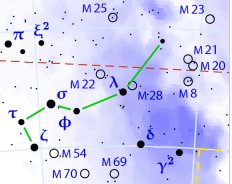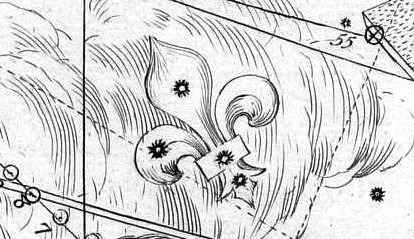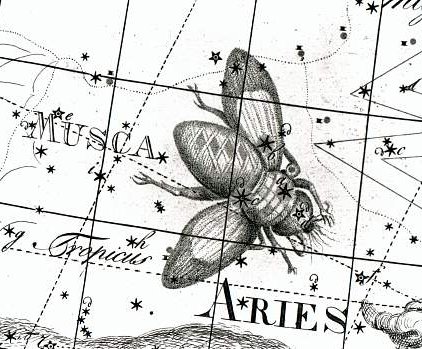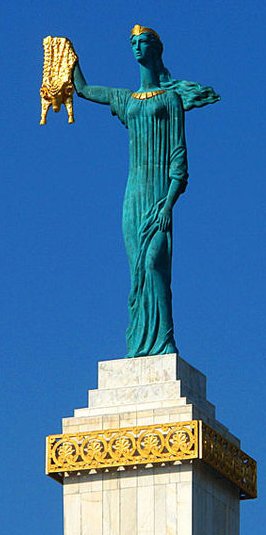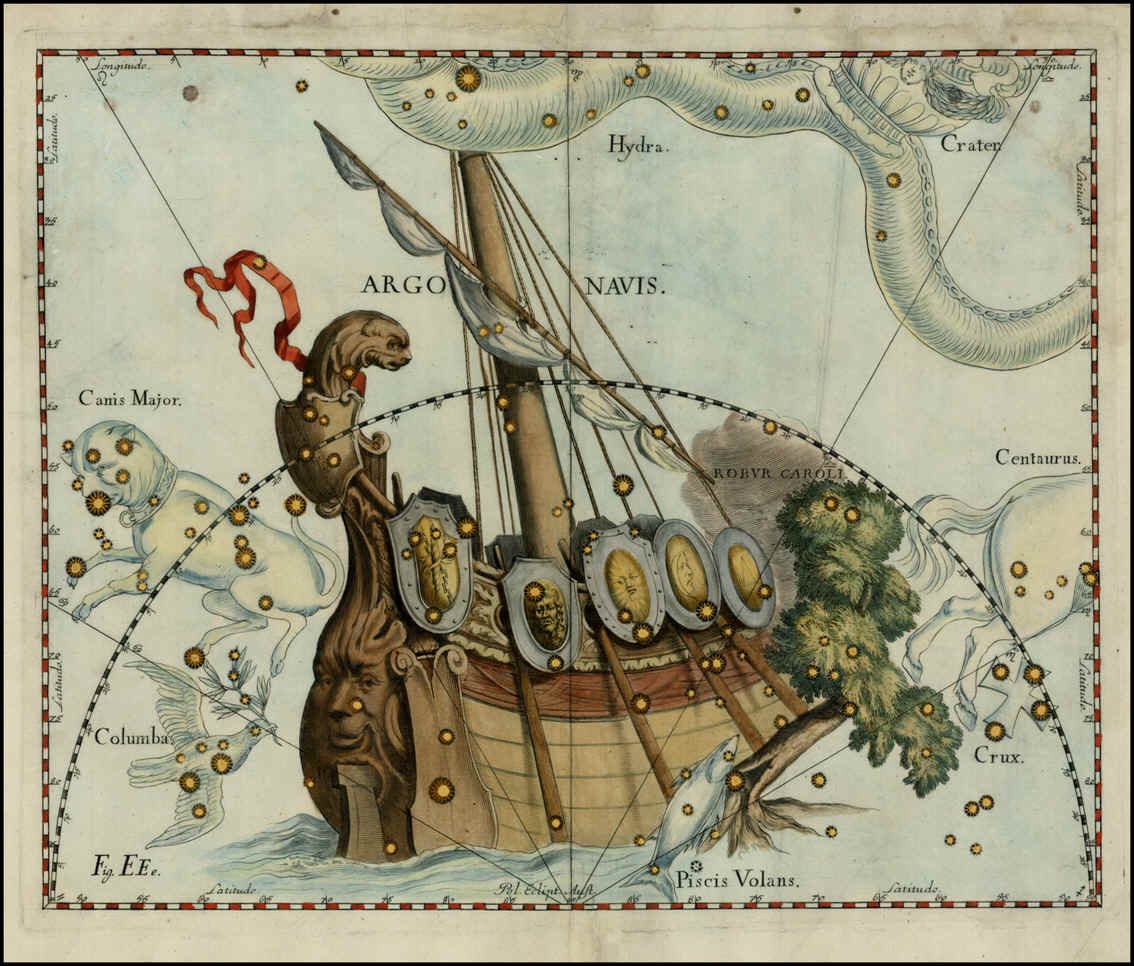131. According to the Chinese system the Monoceros constellation should be considered together with the South Dipper:
We can therefore guess the 'bird with no feet' (A-pus) should be thought of together with Bharani, with the bird in Ga6-19 depicting not Musca Borealis but rather this Bird of Paradise. ... In Bayer's Uranometria from the year 1603 the Bird of Paradise is depicted among the constellations in the southern sky. The name Apus means 'without feet'. The great paradise birds of East India have exceedingly beautiful feathers but very ugly feet. When anciently the natives tried to sell these birds to the Europeans they therefore first cut off their feet ... 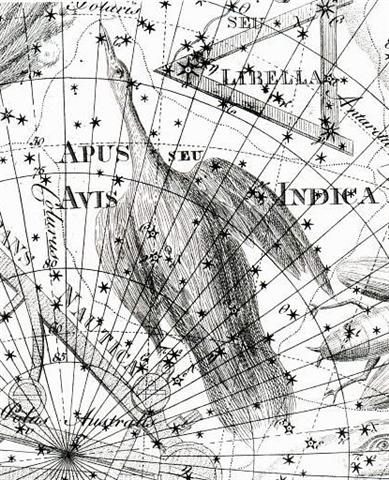 I.e., with 40 days - or 41 days if 39 Arietis had to be counted twice ('Bissextum') - from the Sirrah 'bird' at ο Virginis to the Bird of Paradise, heliacal Bharani should be in May 1 (121 = 80 + 41). *223 (α Apodis) + 183 - 365 = *41 (Bharani). ... Under Mosaic law, a mother who had given birth to a man-child was considered unclean for seven days; moreover she was to remain for three and thirty days 'in the blood of her purification', which makes a total of 40 days ...
The Chinese cue Pheasant seems entirely reasonable, with the 3 stars (sometimes 4) aiming at the Stomach (for the birth soon to come) opposite to the Badger down in his cave in the ground (marking the opposite part of Libra compared to its Neck).
Reading in English Etymology as to the basic meaning of the word pheasant I found information pointing at a river in Colchis, i.e. where they used furs of sheep to trap gold sand in their running streams - the Golden Fleece (with the word fleece originating from a Latin word for feather).
... There remained, however, the problem of getting out of the blocked cave. The Cyclops, groaning, groping with his hands, lifted away the stone from the door, and himself then sat at the entry. And Odysseus cleverly lashed together three large rams of the flock, 'well nurtured and thick of fleece, great and goodly, with wool as dark as violet'. And he prepared in all six triads of this kind. The middle ram of each set was to carry a man clinging beneath, while the side pair were to give protection. And as for himself, he laid hold of a goodly young ram, far the best of all, and curled beneath his shaggy belly; and as soon as early dawn shone forth, the nineteen rams, together with the flock, issued from the cave, bearing seven men ...
... In the description of the Babylonian zodiac given in the clay tablets known as the MUL.APIN, the constellation now known as Aries was the final station along the ecliptic. It was known as MULLÚ.ḪUN.GÁ, 'The Agrarian Worker'. The MUL.APIN is held to have been compiled in the 12th or 11th century BCE, but it reflects a tradition which takes the Pleiades as marking vernal equinox, which was the case with some precision at the beginning of the Middle Bronze Age (early 3rd millennium BCE). In later Babylonian tradition, the name of the constellation changes to MULUDU.NITÁ 'ram'. The motive for the name change is unknown. John H. Rogers suggests that the 'Agrarian Worker' became the 'Ram' via association with the legendary figure of Dumuzi the Shepherd. Gavin White suggests that the sumerogram LÚ 'man' may have come to be understood as Akkadian lu 'sheep'. Aries only rose to its prominent position as the leading sign of the zodiac in the Neo-Babylonian (7th century BCE) revision of the Babylonian zodiac, as Hamal (α Ari) came to be located close to the point of vernal equinox. In Hellenistic astrology, the constellation of Aries is associated with the golden ram of Greek mythology that rescued Phrixos on orders from Mercury, taking him to the land of Colchis. Phrixos sacrificed the ram to the gods and hung its skin in a temple, where it was known as the Golden Fleece. The Golden Fleece was then stolen by Jason and the Argonauts ... The arrangement of the southern birds according to Hevelius shows Apus below the tail bird Pavus (Peacock), which in turn has the beak bird (Tucana) in front. "The title is an appropriate one for enduring stars, as this bird [Pavus] has long before been a symbol of immortality, fancifully said to be from the annual renewing of its feathers; but this is common to all birds, and the symbolism probably is from the fact that its starry tail rendered the peacock sacred to Juno, the immortal queen of the heavens, and thus in classical times, as in the days of chivalry, an object of adjuration. This bird was still further astronomical in originally having been Argos, the builder of the ship Argo, who was changed by Juno to a peacock when his vessel was transformed to the sky, where he has since rejoined her." (Allen)
Above the Toucan the astronomer's bird (Grus) stretched his long neck high with the bird on fire (Phoenix) in front, from where the Eridanus River originated - which was at the opposite side of the sky compared to where the Hydra ended at the black bird Corvus. ... the bird, being sent with a cup for water, loitered at a fig-tree till the fruit became ripe, and then returned to the god with a water-snake in his claws and a lie in his mouth, alleging the snake to have been the cause of the delay. In punishment he was forever fixed in the sky with the Cup and the Snake; and, we may infer, doomed to everlasting thirst by the guardianship of the Hydra over the Cup and its contents. From all this came other poetical names for our Corvus - Avis Ficarius, the Fig Bird; and Emansor, one who stays beyond his time; and a belief, in early folk-lore, that this alone among birds did not carry water to its young ...
... According to a variety of sources of the legend, the Argo was said to have been planned or constructed with the help of Athena. According to other legends it contained in its prow a magical piece of timber from the sacred forest of Dodona, which could speak and render prophecies.
... The Ship appears to have no bow ... Aratos wrote: Sternforward Argō by the Great Dog's tail // Is drawn; for hers is not a usual course, // But backward turned she comes, as vessels do // When sailors have transposed the crooked stern // On entering harbour; all the ship reverse, // And gliding backward on the beach it grounds. // Sternforward thus is Jason's Argō drawn. This loss of its bow is said to have occurred ... when Argō pass'd // Through Bosporus betwixt the justling rocks - the Symplegades, the Cyanean (azure), or the Planctae Rocks at the mouth of the Euxine Sea. Yet Aratos may have thought it complete, for he wrote: All Argō stands aloft in sky. And part moves dim and starless from the prow // Up to the mast, but the rest is bright; and it has often be so illustrated and described by artists and authors ...
|
||||||||||||||||||||||||||||||||||||||||||||||||||||||||||||||||||||||||||||||||||||||||||||||||||||||||||||||||||||
